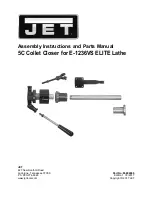
4
2.0
Assembly
Note: The following illustrations may or may not
show your specific lathe model.
1. Disconnect machine from power source.
2. Unpack and clean all rust protected surfaces
with a mild solvent or kerosene. Do not use
paint thinner, lacquer thinner, or gasoline, as
these items will damage painted surfaces.
3. Turn cam locks (A, Figure 1) to release chuck.
Remove chuck and place it on a piece of wood.
Figure 1
4. Clean spindle nose and internal taper
thoroughly.
5. Screw coupling assembly (A, Figure 2) onto
spindle threads located at rear of spindle.
Figure 2
6. Tighten coupling in place using three hex
socket screws (B, Figure 2).
7. Measure runout on coupling using a dial
indicator. Runout should be 0.005” or less.
Adjustments can be made by loosening three
socket head cap screws (C, Figure 2).
8. Thread drawbar (A, Figure 3) into collet closer
assembly (B, Figure 3) until it is flush with the
assembly.
Figure 3
9. Slide collet closer assembly into spindle. Make
sure it completely engages castled gear on the
coupling.
10. Insert collet sleeve into spindle nose (A, Figure
4).
11. Insert collet (B, Figure 4).
Figure 4
12. Screw collet closer into collet by releasing collet
closer assembly lock and turning collet closer
outer flange (B, Figure 3) clockwise. Note: It is
necessary to push in collet while turning closer
body to engage draw bar with collet. Continue
turning until collet taper is seated, but not
tensioned in the taper.
13. Assemble all linkage and attach to collet closer
body (Figure 5).











